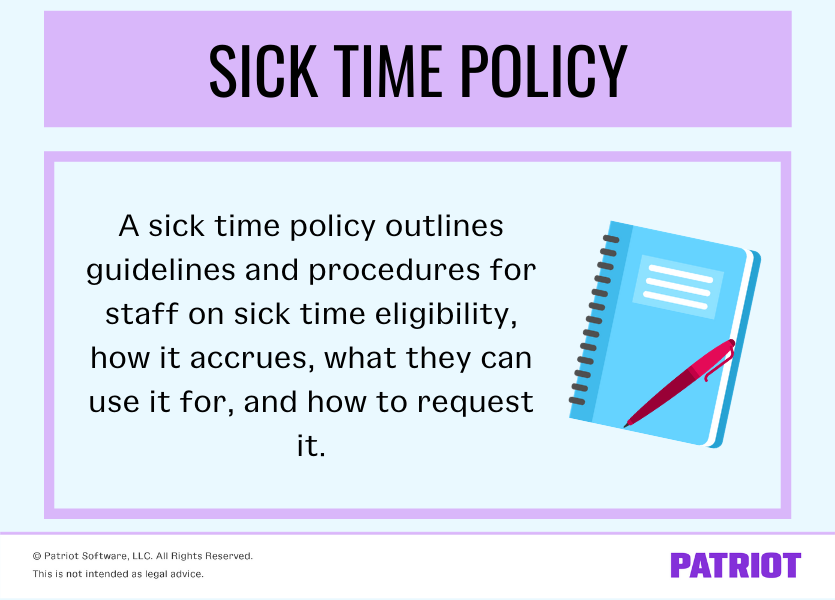Does your business offer sick time to employees? One study showed that having a paid sick time policy can help reduce turnover by 50%. If you want to attract and retain top talent, boost productivity, and reduce the spread of sickness in your workplace, consider drafting a sick time policy for small business.
What should you include in your sick time policy?
A sick time policy outlines guidelines and procedures for staff on sick time eligibility, how it accrues (if applicable), what they can use sick time for, and how to request it. Sick time is typically earned by employees as they work.
Sick leave is generally a longer period of time. It is time off an employee can take if they or a family member are sick. Oftentimes, sick leave and sick time go hand in hand.
Although sick time off policies vary from business to business, they typically include the following sections:
- Employee eligibility
- Accrual rate
- Uses
- Sick time requests
- Unused sick time rules
Employee eligibility
In this section, clarify which employees are eligible for paid sick time. Eligibility for sick time can depend on:
- The employee’s role
- Number of hours the employee works
- How long the employee has worked for the company
Based on your state, you may be able to limit sick time to employees with certain job roles and duties (e.g., service workers). And depending on the state your business is in, employees may need to work a certain number of hours to qualify for paid sick leave.
In addition, you can require employees to work for the business for a certain number of days before they’re eligible. For example, you may require employees to work for your business for 90 days before they can be eligible to begin accruing paid sick time.
Accrual rate
Your policy should include how much sick time or leave an employee can accrue and how the accrual process works.
Sick time generally accrues based on the number of hours an employee works. Some states require paid sick time accrual for employees. Accrual rates, caps, and laws vary from state to state. For example, in Arizona, employees at eligible businesses accrue one hour of paid sick leave for every 30 hours worked.
If you offer sick time to employees outside of mandatory paid sick leave, determine an accrual rate, cap, and how long employees have to wait before using earned sick time. You should also decide if you want sick time to accrue gradually or offer it as a lump sum at the beginning of the year.
Uses
You don’t want your employee to be able to use sick time all willy nilly. They have to have a legitimate reason when they use it.
When drafting your policy, include a section that lists out what employees can use sick time for. Here are a few examples of uses for employee sick time:
- Common cold / flu symptoms
- Stomach bug / food poisoning
- Taking care of an ill family member (e.g., spouse, parent, or child)
- Mental health
- Doctor’s appointment
- Other illnesses or medical issues
Along with having a list of reasons for using sick time, include what sick time can’t be used for. Don’t forget to include disciplinary actions you will take if an employee misuses sick time.
Sick time requests
Your policy should have a section that gives employees instructions on how to request and take sick time.
In this section, cover who the employee needs to communicate sick time requests to (e.g., manager or supervisor), how they need to request it (e.g., in their employee portal), and how far in advance they must notify you (e.g., ASAP if sick time is unexpected).
Also include whether the employee needs to show documentation that supports their sick time request. You may require employees to provide things like a doctor’s note to prove their absence, especially if the employee is going to be absent for a longer period of time. Lay out your rules about supporting documentation, including:
- When the employee needs to provide documentation to receive sick pay
- Type of documentation (e.g., letter or doctor’s note)
- What information the documentation needs to include (e.g., date, signature, etc.)
Unused sick time rules
This portion of your policy should go over your business’s unused accrued sick time rules. Include what will happen to employees’ accrued sick time hours if they do not use them by year-end.
You may allow employees to do one of the following with their unused sick time:
- Carry over the sick time hours to the next year
- Cash out the value of accrued sick time hours
- Use it before the end of the year
- Forfeit the accrued time
In this section, also include how you will handle accrued sick time for terminated employees.

Before you create your sick time off policy…
Before you can create your sick time off policy for employees, consider a couple of things: sick time laws and payroll.
Do your research on sick time laws
Like many things in business, you should do your homework before making a sick time policy for your company.
An important part of offering sick time to employees is ensuring you stay compliant with sick time- and leave-related laws. When it comes to some states, you may have no choice but to offer employees paid sick time.
Before you create and implement a sick time policy, review paid sick leave laws by state. Paid sick leave laws may include rules about accrual rates and caps, what employees can use sick leave for, and more.
Keep in mind that you can opt to go beyond the state’s requirements (e.g., letting employees accrue additional time off than what the law requires).
Consider how it will impact your payroll
Can your payroll software handle sick time accruals? Do you have a way to track employee sick time hours? These are questions you need to ask yourself before you create a sick time policy for your company.
If you utilize payroll software, find out if you’re able to record sick time hours. If you do payroll manually, don’t forget to account for sick time hours for employees.
To better track employee sick time hours and stay organized, consider also investing in a time and attendance software if you don’t already have one. That way, you can easily track accrued sick time for each employee.
After you establish your employee sick time policy…
After you launch your sick time policy, you have a couple more responsibilities, like posting in your workplace and informing employees.
Inform employees
Once you establish your sick time policy, inform your employees right away.
Consider hosting a meeting to discuss your policy. That way, employees can have the opportunity to ask you questions. You can also send out an email or memo to employees to tell them about the new policy.
Include your sick time policy in your employee handbook so employees can easily access it.
If you make any changes to your policy, distribute a revised version of your sick time policy to employees for review.
Make any required postings
Some paid sick leave laws require employers to hang posters that include sick leave rules and requirements in the workplace.
If you must follow sick time laws, check with your state to find out what posters you need to display at your business. Post the notices in common areas where employees can view and read them, such as a break room or lounge.
Need help recording how much sick time your employees accrue and use? Patriot’s time and attendance software is a great add-on to our online payroll software. Try both for free today!
What’re your thoughts on this article? Head over to Facebook to let us know!
This is not intended as legal advice; for more information, please click here.



